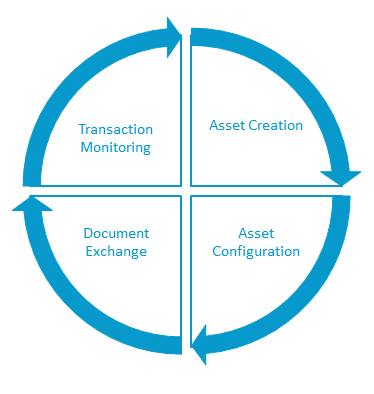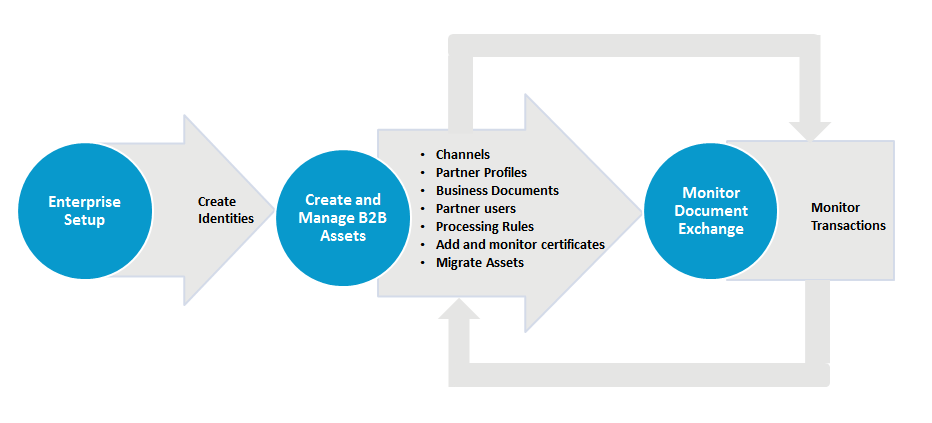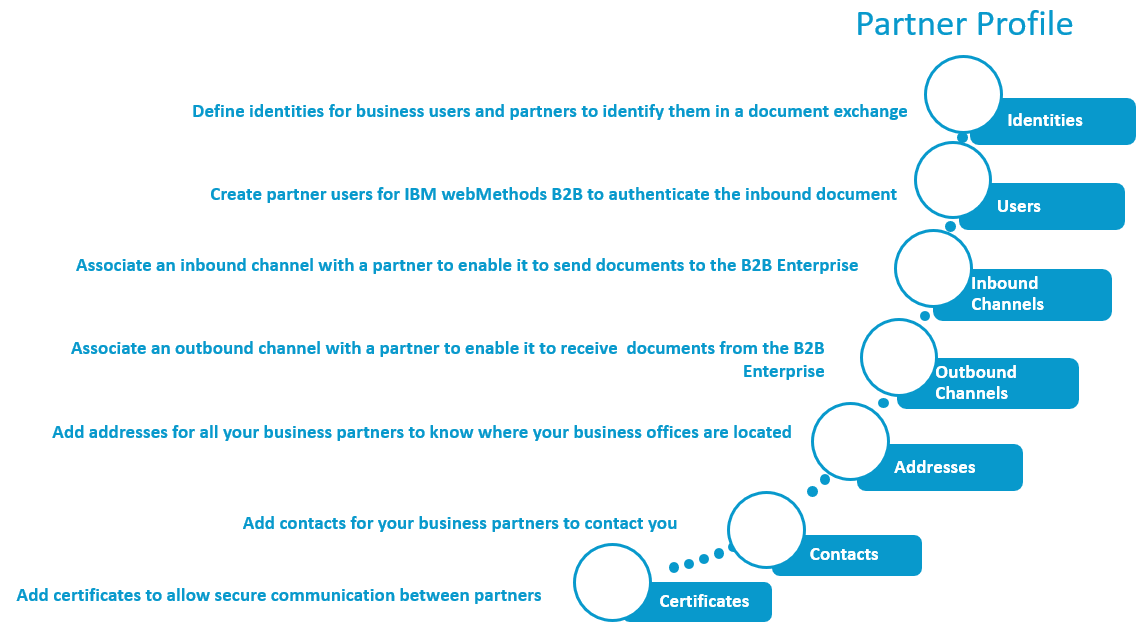Overview
Understanding the TerminologyThe IBM webMethods B2B is IBM’s secure, format-neutral, business-document gateway that recognizes and processes documents that are exchanged between partners. Through IBM webMethods B2B, you can exchange business documents with the partners in your network to relay production information.
IBM webMethods B2B allows you to create a B2B network, which is a group of organizations that have agreed to exchange business documents. Participant organizations might include strategic partners, buyers, suppliers, and marketplaces (for example, Ariba Network). These participant organizations are referred to as partners.
Business documents that partners exchange include purchase orders, order statuses, purchase order acknowledgments, invoices, and other domain-specific documents. IBM webMethods B2B enables your corporation to connect to other organizations to form a business-to-business (B2B) network.
IBM webMethods B2B does not require that all partners in the network use IBM webMethods B2B or IBM webMethods software. Each of your partners could use their own software to communicate with your instance of IBM webMethods B2B. If you have buyers, suppliers, or strategic partners who use other software, you can add them to your network by creating partner profiles for each of them. Partner profiles contain information about how to connect to the partners and share information.
In the following figure, the partner in the center is referred to as the hub of the network or the enterprise partner. The other partners are referred to as spokes. The hub hosts the network and the spokes participate by interacting with the hub. A partner does not have to be exclusively a hub or a spoke; it can be both. It can be a hub of its own network and a spoke in another partner’s network.

IBM webMethods B2B satisfies the following business needs:
- Complete life-cycle management of business documents.
- Complete monitoring and tracking of a single transaction in an orchestrated environment.
Understanding the Terminology
The following table lists all the terms associated with IBM webMethods B2B.
| Term | Description |
|---|---|
| Activities | A log that IBM webMethods B2B maintains to record the activities that occur within IBM webMethods B2B. Modifications, updates, activities related to document exchange are typical entries on the Summary page for Transactions. For example, an activity entry is made when you modify partner information, or when IBM webMethods B2B processes documents, or when you perform administrative tasks. |
| Channel | A channel forms the basis of communication in IBM webMethods B2B. It encompasses a variety of underlying protocols such as HTTP, AS2, and so on to facilitate document exchange. All transactions among partners therefore leverage the underlying transport and exchange capabilities of channels. |
| Comment | Add or update a comment associated with the document. For example, if multiple users are responsible for handling documents that have processing errors, you might want to add comments to indicate that you are working on resolving an issue and the steps that you have taken. |
| Outbound Channel | A method for delivering a document to a partner. For example, deliver a document using HTTP. IBM webMethods B2B supports delivery by using receiver’s preferred outbound channel. |
| Business Document | A business document (for example, purchase order, acknowledgment, confirmation) sent to IBM webMethods B2B. You define exactly one type of business document for each document you expect to receive or send. |
| Enterprise | An enterprise is a special partner that typically represents a corporation, also known as the hub, local partner, or sponsor. |
| Functional Acknowledgment | A functional acknowledgment (FA) is a transaction set sent by the receiver of an EDI transmission to the sender, acknowledging that the message has been received and its syntax is acceptable. Functional acknowledgments do not indicate that the document has been processed by the receiver. Functional acknowledgments are generated only for inbound documents from a trading partner. Functional acknowledgments are not created when a document submission is internally tested using the Test Document feature, or when a document is submitted to IBM webMethods B2B by an integration. |
| Inbound Channel | A method for receiving a document from a partner. |
| Identity | The value of the identity type within a document. Several identity types are available in IBM webMethods B2B. For example, if the identity type is a DUNS number, the identity is the actual value of the DUNS number. |
| Profile | A IBM webMethods B2B object that contains a summary of information about a corporation that is part of a B2B network. A profile holds details about a corporation such as identities, connections, certificates, contacts, and addresses. |
| Partner User | A partner user is an entity authorized to send business documents in IBM webMethods B2B. |
| Processing Rules | A IBM webMethods B2B object that contains a set of actions that determine how IBM webMethods B2B must process an inbound document with the specific criteria. |
| Partner | A partner is a participant organization in your B2B network. It could be a strategic partner, marketplace, buyer, or supplier. Each partner requires a profile. You can exchange business documents with the partners in your network to relay mission-critical production information. |
| Preferred Outbound Channel | A partner’s preferred protocol through which it wants to receive documents in IBM webMethods B2B. |
| Reprocess | When you reprocess a document, you send the document back through the processing rules. For example, you will reprocess a document if the document was processed by the wrong processing rule. Note: If you reprocess a document for which the document attributes were not saved, the document will not match with the processing rules that use that criteria. Instead, the document matches with another processing rule, such as the Default rule, and performs the processing actions defined in that rule. |
| Resubmit | When you resubmit a document, you send the document to IBM webMethods B2B as a new document. For example, you might resubmit a document when the document does not match any type of business document. When you edit a document and resubmit it, IBM webMethods B2B creates a new instance of the document, and continues to process it while the original document remains unchanged. |
| Service execution | Call an integration that is designed using IBM webMethods Integration or any other integration software. You can use one of the following service execution modes to call an integration
|
| Tasks | IBM webMethods B2B creates tasks internally to monitor service execution (if the service execution mode is set to Reliable) or for delivering the document by using receiver’s preferred outbound channel. |
| Transaction | An end-to-end business-to-business document exchange corresponds to a transaction in IBM webMethods B2B. Regardless of the type of documents, channels used, a transaction is a neutral runtime aspect of a business-to-business document exchange flow. |
| Validators | Different types of validators are available to validate records, composites, and fields of a business document. You can validate:
|
Lifecycle of B2B Assets
No subtopics in thissection
The assets you create on IBM webMethods B2B are referred to as B2B assets. These assets undergo transitions in a specific manner as depicted in the following image.

Enterprise Profile
No subtopics in thissection
An enterprise is a special partner that represents a corporation, also known as the hub, local partner, or sponsor.
Click Set up my IBM webMethods B2B on the welcome screen to open the guided wizard to set up the enterprise.
You can only modify details of an enterprise profile but cannot delete it.

Partner Profiles
Partner UsersA partner profile holds details about a corporation such as identities, connections, certificates, contacts, and addresses.
Partners can send and receive documents to IBM webMethods B2B for processing. After processing documents using processing rules, the business documents are delivered as defined in the processing rule.
In IBM webMethods B2B, users associated with the partner are the entities that authenticate a document exchange.
To create a partner profile, you must minimally define an identity for that partner. An identity primarily identifies a partner in IBM webMethods B2B. The combination of identity type and identity value must always be unique for a partner.

You can add as many partner profiles as you want. IBM recommends that you keep this information up to date.
Important: IBM webMethods B2B does not process or utilize any personal information (email ID, role, address, telephone details and so on) for any purpose.
Partner Users
IBM webMethods B2B accepts and processes the documents from a partner only if it has a user associated with it. The user credentials of a partner user are used to authenticate a business document exchange in IBM webMethods B2B.
Monitoring Transactions
No subtopics in thissection
An end-to-end business-to-business document exchange corresponds to a transaction in IBM webMethods B2B. Regardless of the type of documents, channels used, a transaction is a neutral runtime aspect of a business-to-business document exchange flow.
You can search, view, and monitor transactions using the simple search capabilities.
Monitoring enables you to:
Track transaction information about the documents that your IBM webMethods B2B has sent, received, or delivered.
Track transactions created as part of an integration where one transaction may generate many transactions for its end-to-end completion and subsequently monitor them in the Course of transaction section of the Transaction summary page.
Search for a specific transaction.
Resubmit and reprocess a transaction.
Edit and resubmit the content of a document.
Add a comment to a transaction.
View the attributes for a document.
View all related transactions in a single group.
Download a precise list of live transactions by applying search filters.
IBM webMethods B2B provides better availability support for the product and infrastructure. This allows having multiple replicas for paid tenants.
This capability ensures a new processing node is assigned as soon as the current processing node fails.
Note that this is only a high availability support and not failover support. This means that the transactions in-flight may fail and those may need to be resubmitted or reprocessed.
Any new transactions will be successfully processed on the newly assigned node.
 .
.